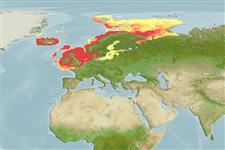Environment: milieu / climate zone / profondeur / distribution range
Écologie
marin démersal; profondeur 3 - 78 m (Ref. 51661). Temperate; 81°N - 48°N, 25°W - 62°E
Northeast Atlantic: southern Norway north to Barents Sea including Novaya Zemlya, Spitsbergen and Bear Island, also Iceland.
Taille / Poids / Âge
Maturité: Lm ? range ? - ? cm
Max length : 15.0 cm TL mâle / non sexé; (Ref. 4645)
Suction disc much larger than the eye diameter. Dorsal and anal fins overlap with the caudal fin. Two nostrils on each side of the snout (Ref. 35388).
Body shape (shape guide): elongated.
Occurs from the subtidal zone to less than 300 m (Ref. 4702). Feeds primarily on crustaceans, occasionally fishes and polychaetes (Ref. 4702). Spawns in the winter (Ref. 35388).
Life cycle and mating behavior
Maturité | Reproduction | Frai | Œufs | Fécondité | Larves
Perlmutter, A., 1961. Guide to marine fishes. Bramhall House, New York. 431 p. (Ref. 169)
Statut dans la liste rouge de l'IUCN (Ref. 130435: Version 2025-1)
Menace pour l'homme
Harmless
Utilisations par l'homme
Pêcheries: sans intérêt
Outils
Articles particuliers
Télécharger en XML
Sources Internet
Estimates based on models
Preferred temperature (Réf.
123201): 4.9 - 11.4, mean 8 °C (based on 512 cells).
Phylogenetic diversity index (Réf.
82804): PD
50 = 0.5000 [Uniqueness, from 0.5 = low to 2.0 = high].
Bayesian length-weight: a=0.00525 (0.00237 - 0.01161), b=3.15 (2.96 - 3.34), in cm total length, based on LWR estimates for this (Sub)family-body shape (Ref.
93245).
Niveau trophique (Réf.
69278): 3.6 ±0.58 se; based on food items.
Résilience (Réf.
120179): Faible, temps minimum de doublement de population : 4,5 à 14 années (Fecundity assumed < 100).
Fishing Vulnerability (Ref.
59153): Low vulnerability (10 of 100).
🛈
